Teochew rice drawings: Capturing the divine in grains of rice
During religious rituals at Teochew charitable halls, intricate images of religious figures and symbols are created, not with ink, but with rice grains. Crafting these rice drawings requires skill, attention to detail, dexterity and artistic talent. Lianhe Zaobao lifestyle correspondent Tang Ai Wei speaks with several rice drawing artists and discusses the traditional art form.
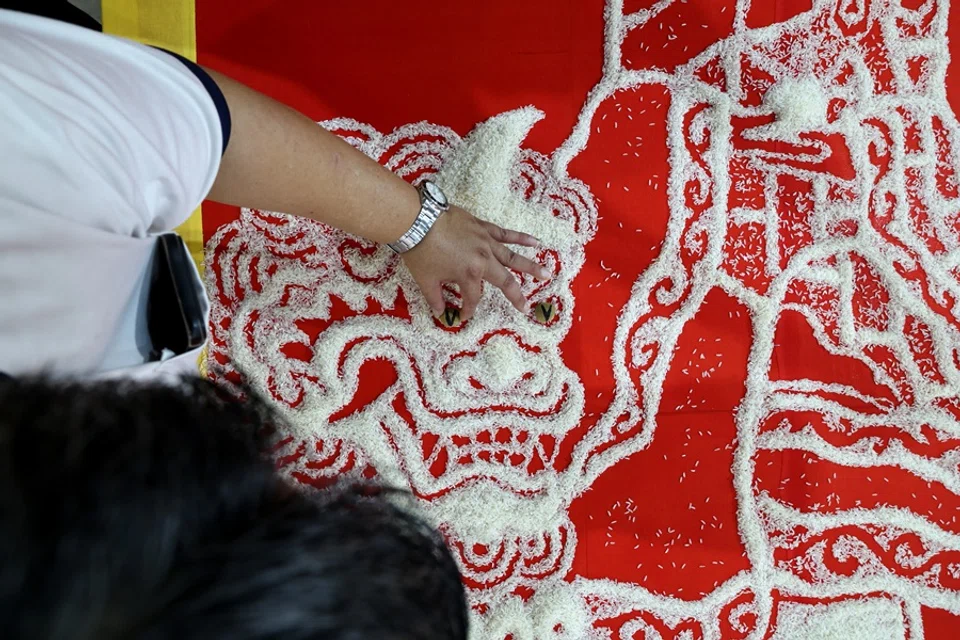
(Photos: Long Kwok Hong/SPH Media, unless stated otherwise.)
Mitu (米图), or rice drawing, is also known as youming tu (幽冥图), literally “netherworld drawing”. In Singapore, this practice is primarily observed at events held in Teochew charitable halls (善堂). Because the Teochew dialect pronounces both “table” and “bed” as “ceng”, these rice drawings, typically arranged on a table in the halls, are referred to as a “rice bed” (米床).
Charitable halls are folk charitable organisations that emerged during the Song dynasty and flourished in the Ming and Qing dynasties. They regard the Song dynasty monk, Grand Master Song Dafeng, as their central figure of worship.
From Song dynasty to Singapore
Singapore’s charitable halls actively supported the community during the Japanese occupation of World War II by burying the dead, providing medical care and medicine, and assisting with emergency relief for injuries. They also conducted Buddhist rituals, chanting, and ceremonies to help lost or wandering souls transit to the afterlife.
The music and ritual section of the charitable halls offers “merit-making” (做功德) services, which involve setting up altars and chanting sutras at funerals to guide the deceased in their journey to the afterlife. These ceremonies can last an entire day, from 9am to 10pm or even longer.
Rice drawings are featured during the guan deng ke yi (关灯科仪) part of the ritual. Apart from various ritualistic ceremonies, universal deliverance rituals during the Hungry Ghost Festival in the seventh lunar month, and deity birthday celebrations, rice drawings are also featured in some death rites. Typically, red backgrounds are used for celebratory occasions, while blue backgrounds are used for funerals.
“I first learnt how to arrange straight and curved lines, then some basic images. I started from a small image on a table three feet long and three feet wide.” — Francis Tan Kwee Chye, a rice drawing master
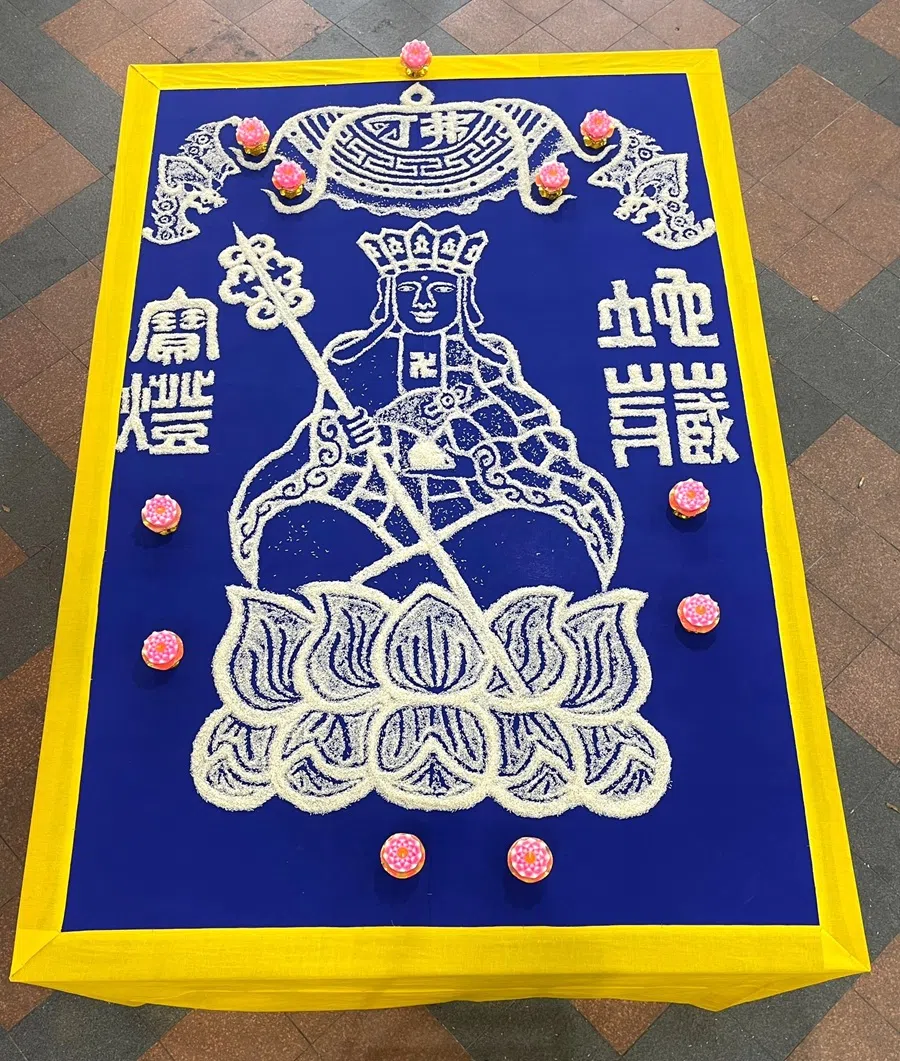
Rice drawings require an artistic eye and dexterity
Large-scale rituals are not frequently held. However, in November last year and April this year, two massive rice drawings were individually arranged by two experienced masters, and the photojournalist was able to capture these precious images.
Since young, 49-year-old Francis Tan Kwee Chye has been fascinated by the vibrant colours and vivid forms of deity statues. Before the age of ten, he had already started to imitate and carve them. After entering the workforce, he worked in drafting before dedicating himself full-time to the zhizha (纸扎, traditional paper craft used mainly to create offerings for religious ceremonies) industry in 2017.
Tan, who had a keen interest in folk beliefs, customs and art, began serving at charitable halls in his twenties. Recalling the first time he saw the arrangement of a rice drawing, he told Lianhe Zaobao, “Like many people, I was very curious. After observing for a year or two, the master in charge saw my interest and asked if I wanted to try arranging one. I first learnt how to arrange straight and curved lines, then some basic images. I started from a small image on a table three feet long and three feet wide.”
“I first convert the colourful pattern into black and white in my mind, then think about how to arrange the lines to achieve a three-dimensional effect.” — Tan
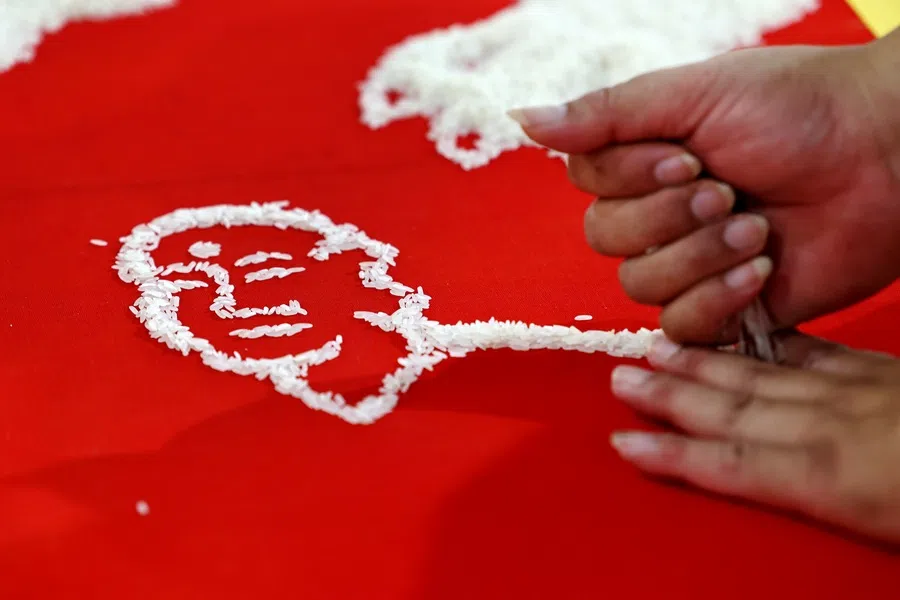
As the saying goes, “The master teaches the trade, but the apprentice’s skill is self-made.” Tan gradually developed his own method of arrangement, showcasing a unique artistic style.
“Each time I see a beautiful image, like a portrait, an animal or scenery, I will begin to think about how it can be translated into rice arrangements. I first convert the colourful pattern into black and white in my mind, then think about how to arrange the lines to achieve a three-dimensional effect,” he shared.
Admittedly, Tan is a remarkably talented artist. After several interviews and after observing his works, I noticed his exceptional eye for aesthetics and the dexterity of his hands. The ritual offerings he creates are both spiritually and visually impressive, with meticulous attention to detail.
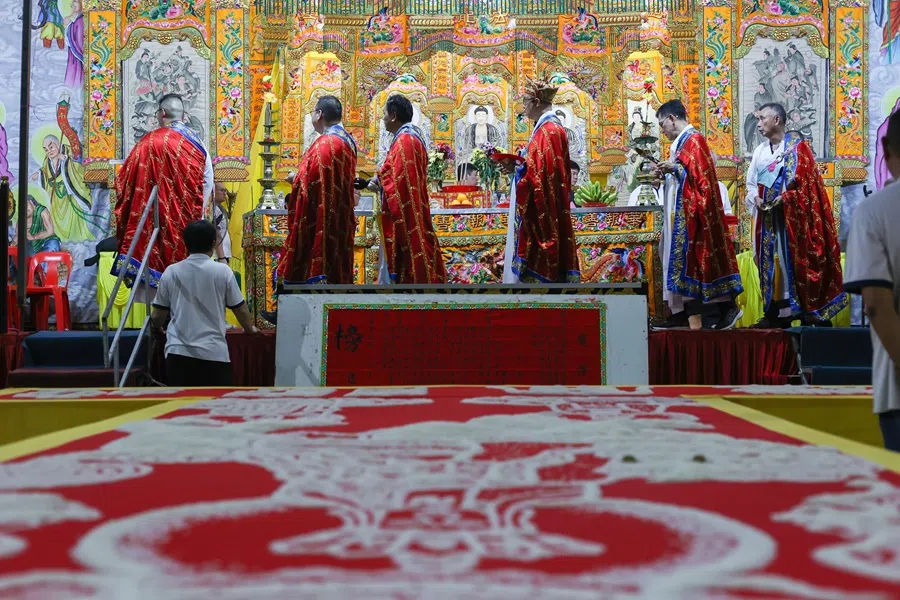
Tan’s rice drawings, though made only with white rice grains against a red cloth as the background, display a rich sense of depth and three-dimensionality due to his clever manipulation of the distribution, arrangement, and layering of the rice grains, making the overall image appear more vivid and lifelike.
No drafts needed
On 25 November last year (the 25th day of the tenth lunar month), the Hwa Poh Siang Tng (华报善堂) at Yishun Ring Road held a day-long ritual to celebrate the birthday of Grand Master Song Dafeng. Tan reached the venue around 11 am to create a rice drawing and only completed it at 7 pm, after using approximately 20 kilograms of white rice.
This complex divine beast is a combination of a tiger, dog, dragon, lion’s tail and qilin features, and the final result relies on the dexterity of the master’s hands.
The four large characters Di Zang Bao Deng (地藏宝灯, Bodhisattva Ksitigarbha’s lantern) measured 3 feet tall and 12 feet wide, while the image of Ksitigarbha measured 12 feet tall and 6 feet wide. Ksitigarbha was depicted with a jewelled canopy overhead, riding his divine beast, Diting. On the right was his first disciple, the Venerable Daoming (道明), and on the left was his second disciple, the Venerable Mingong (闵公). Two bats were also included, symbolising “having blessings” (有福) and “bestowing blessings” (赐福).
Although Ksitigarbha is commonly depicted sitting on a lotus throne in rice drawings, Tan later experimented with having him mounted on Diting. This complex divine beast is a combination of a tiger, dog, dragon, lion’s tail and qilin features, and the final result relies on the dexterity of the master’s hands.
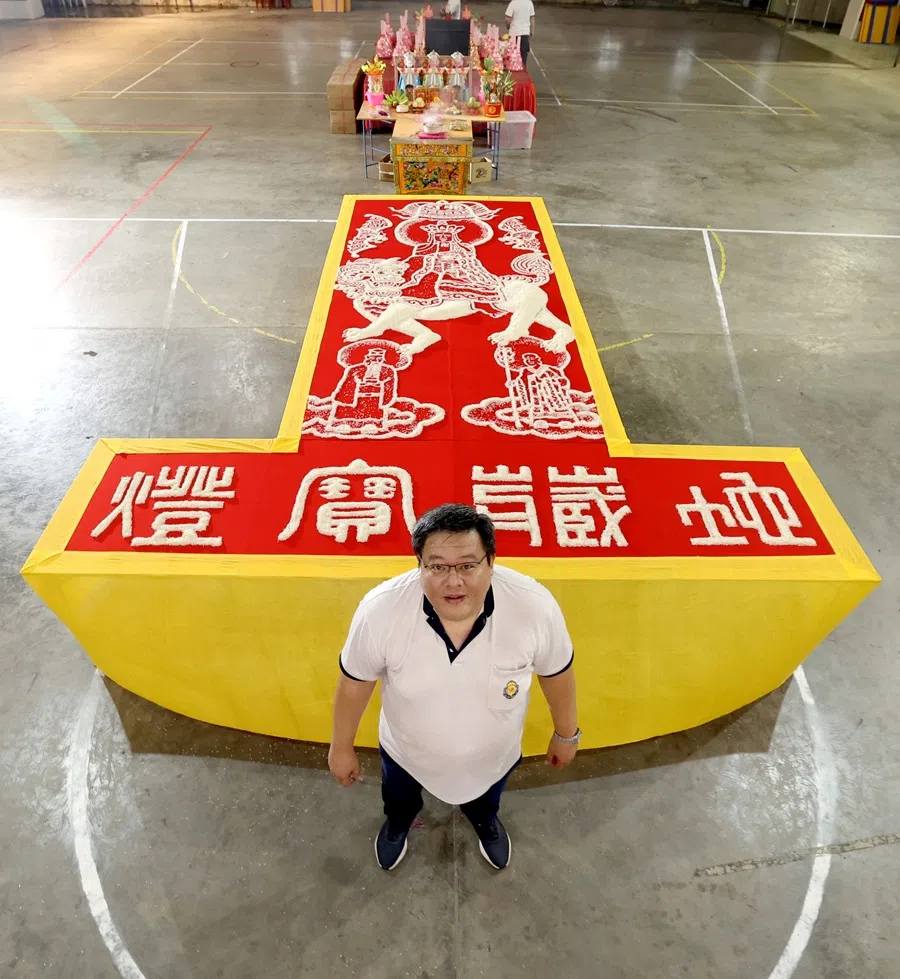
“Everyone has their own method. For me, I look at the size of the table and arrange the rice directly based on visual estimation, without making any markings or drafts. For larger rice drawings, I add more elements, such as the Venerable Daoming and the Venerable Mingong. Arranging figures is incredibly challenging. Not only must the proportions be right, the finished product must be instantly recognisable,” Tan said.
“If I have ample time, I can create more layers. The type of rice also matters. As soon as I reach into the rice bag, I can tell whether the rice grains are suitable for the drawing. Some types of rice are too smooth and won’t stack, making it difficult to achieve a three-dimensional effect.”
The rice drawing is eventually swept back into a pile of rice, marking the completion of the ritual. This rice is then divided into small bags for devotees to take home.
A difficult but fulfilling craft
The guan deng ke yi ritual involves the lighting of 11 lanterns to summon Ksitigarbha, the Lord of the Underworld, and the Ten Kings of Hell to the ritual site to guide the soul to peace and freedom from suffering.
During the rite, the chanters would circumambulate the rice drawing while chanting sutras, then sweep over it with their hands or Dharma tools. The rice drawing is eventually swept back into a pile of rice, marking the completion of the ritual. This rice is then divided into small bags for devotees to take home.
Tan was initially saddened about how his rice drawing would be swept away within minutes, after he spent hours painstakingly creating it. However, he eventually accepted its short-lived nature.
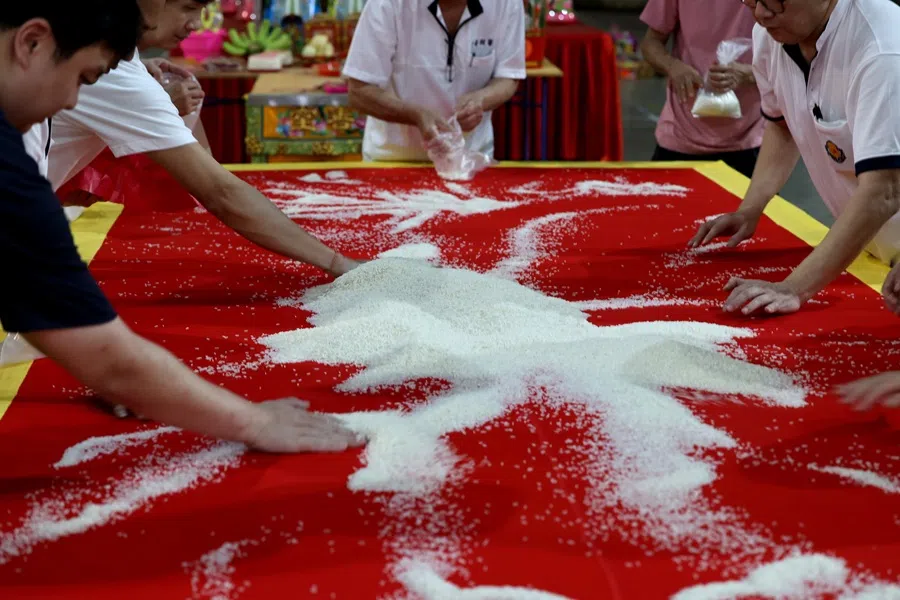
Before the pandemic, he created rice drawings five to eight times a year. Now, with fewer ceremonies, he creates fewer than five annually. Like other volunteers, Tan only gets a travel allowance, without any additional compensation. To him, creating rice drawings is not about seeking merit or blessings. Instead, it is about the joy and fulfilment he finds in carefully arranging rice grains into solemn and majestic images of deities.
Words instead of images
At the age of eight, Nelson Woo Ngee Guan joined the music and ritual section at Seu Teck Sean Tong Yiang Sin Sia (新加坡修德善堂养心社). There, he learned scriptures and delved into the traditional culture of charitable halls, guided by experienced mentors. Today, he is the secretary general of the Blue Cross Charitable Institution (中华善堂蓝十救济总会) and Seu Teck Sean Tong. Additionally, he serves as an adviser and mentor to various charitable halls in China, Singapore and Malaysia.
About 20 years ago, he began using edible food colouring to dye the white rice into vibrant colours, with the hope that the lives of believers would be as rich and colourful as the rice drawing he creates.
In his mid-teens, Woo learned Teochew rice drawing from his mentor Lee Seah Pheow. He adopted his mentor’s tradition; instead of creating images of Bodhisattva Kshitigarbha, he arranges the four Chinese characters Di Zang Fu Deng (地藏福灯, Kshitigarbha’s blessing lantern) for regular events and Di Zang Bao Deng (地藏宝灯, Bodhisattva Ksitigarbha’s lantern) for funerals.
He begins by marking the patterns and characters on the table, and uses incense sticks to guide the rice grains into lines. He then finishes the drawing by marking out the finer details with his fingers. About 20 years ago, he began using edible food colouring to dye the white rice into vibrant colours, with the hope that the lives of believers would be as rich and colourful as the rice drawing he creates.
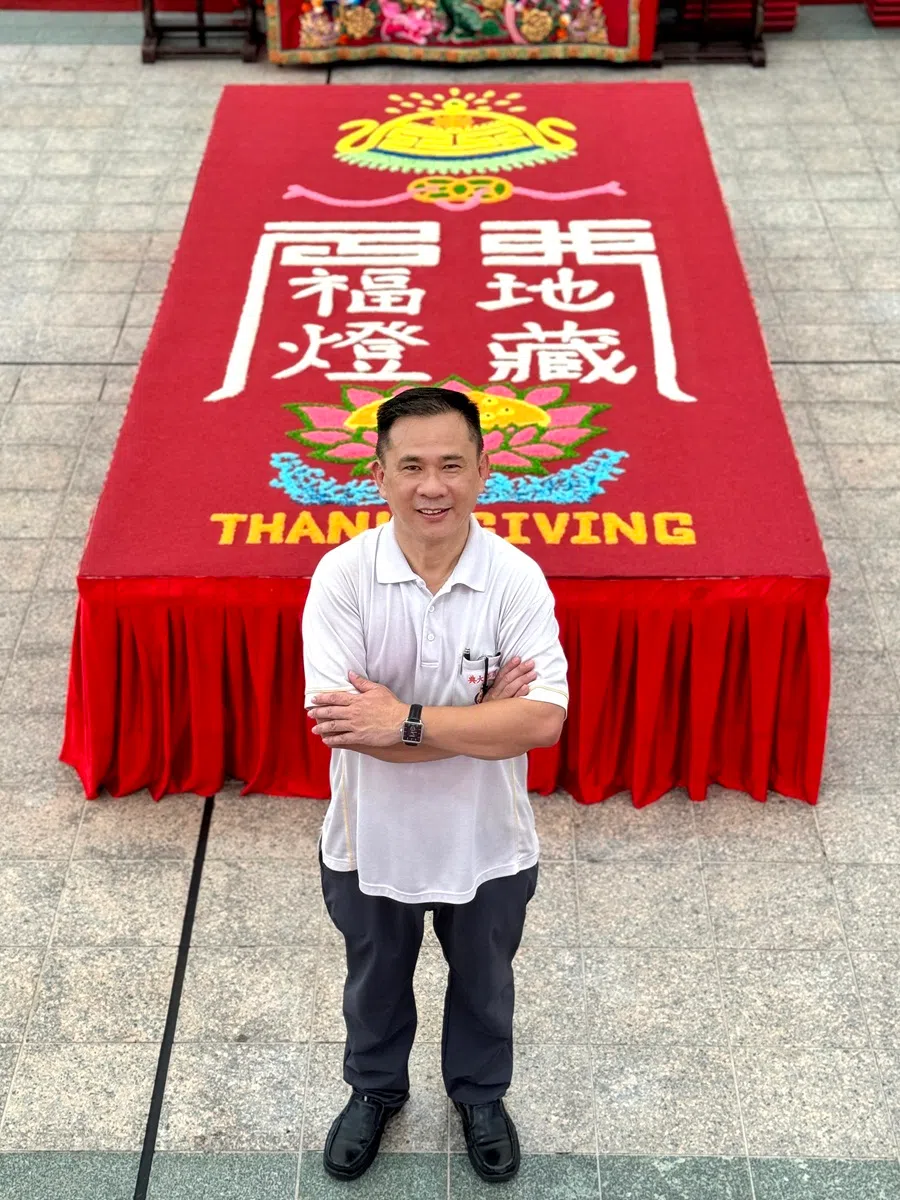
From 11 to 13 April this year, Seu Teck Sean Tong hosted Thanksgiving Ritual Prayers (酬谢天地父母众位诸神鸿恩暨济幽大法会) at Ngee Ann City Civic Plaza. Woo chaired the organising committee and crafted a rice drawing measuring 24 by 6 feet.
Woo shared, “I started dyeing the white rice a few days earlier because it needed to dry before use. Creating the rice drawing took about 20 hours and around 10 kilograms of rice.” After finishing basic elements like the canopy, the words Di Zang Fu Deng and the lotus throne, he enhanced the design by adding four bats and some flowers.
Interestingly, the English word “Thanksgiving” was also included at the bottom of the rice drawing. Woo explained, “Since the rice drawing was displayed on Orchard Road, it would attract many tourists and passersby. The English word would let them know that this is an event to give thanks to the deities.”
Record-breaking rice drawing
In 2017, the Blue Cross Charitable Institution created a massive rice drawing installation of Grand Master Song Dafeng to celebrate their 75th anniversary. The installation, which comprised 3000 kg of white rice and 800 kg of brown rice, was the size of a basketball court and was recognised as the “Largest Rice Art Display” in the Singapore Book of Records. Spanning 22 by 14.6 metres, the piece involved over 100 volunteers and took about 10 hours to complete. Woo was the chief planner of this monumental piece.
Even a small disruption, such as someone bumping the table, can cause the grains to shift. Completing such intricate work, therefore, demands much dedication and resilience.
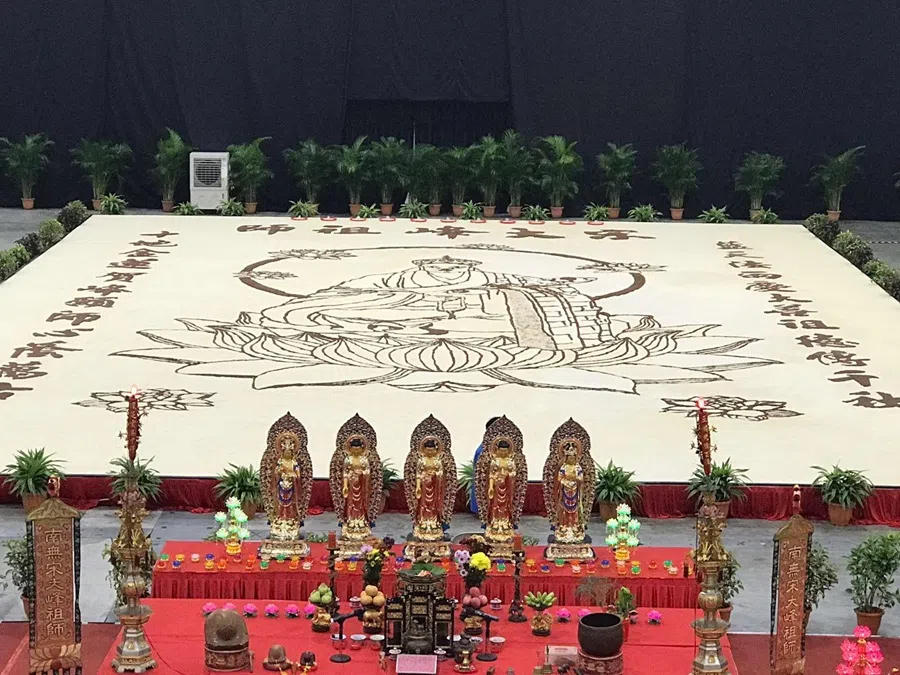
Woo, who has served in the charitable hall community for almost 50 years, told me that earlier rice drawings were mostly small. In the 1990s, he began creating larger rice drawings and found them to be more visually impactful. Other rice artists followed his lead, and large-scale rice drawings soon became a distinctive feature of Singapore’s charitable hall culture. Now, Woo and other mentors get invited to Malaysia and China to create and showcase their work, promoting this art form beyond Singapore.
Rice drawings are usually created outdoors, with only a tent to shield the artists from the sun, making the environment uncomfortably hot. Artists must bend over for long periods, using their hands and fingers to carefully arrange the rice grains into precise lines and patterns. Even a small disruption, such as someone bumping the table, can cause the grains to shift. Completing such intricate work, therefore, demands much dedication and resilience.
Today, only a few mentors skilled in creating large-scale rice drawings remain in Singapore. Each has their own unique technique and artistic vision, and they often prefer to work independently to highlight their dedication and personality.
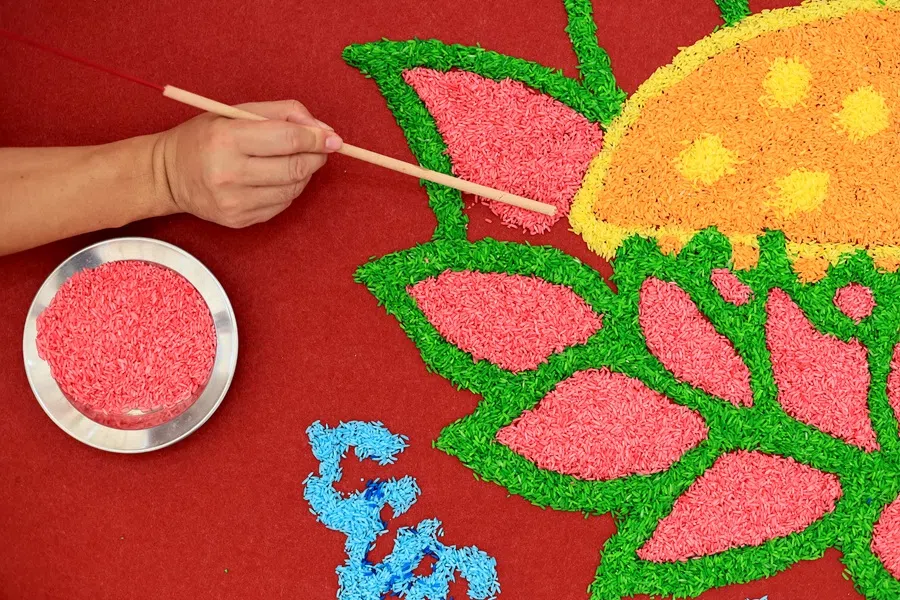
Rice drawings are similar to the Indian floor art Rangoli in that both are culturally rich and visually appealing. Both Woo and Tan believe this art form deserves more attention. This December, the Blue Cross Charitable Institution will host its second art competition and exhibition. The public will have the opportunity to attend workshops where they can use rice grains to create Chinese characters such as fu (福, meaning blessing) and shan (善, meaning kindness).
This article was first published in Lianhe Zaobao as “潮州善堂独特仪式 手砌米图粒粒皆艺术”.

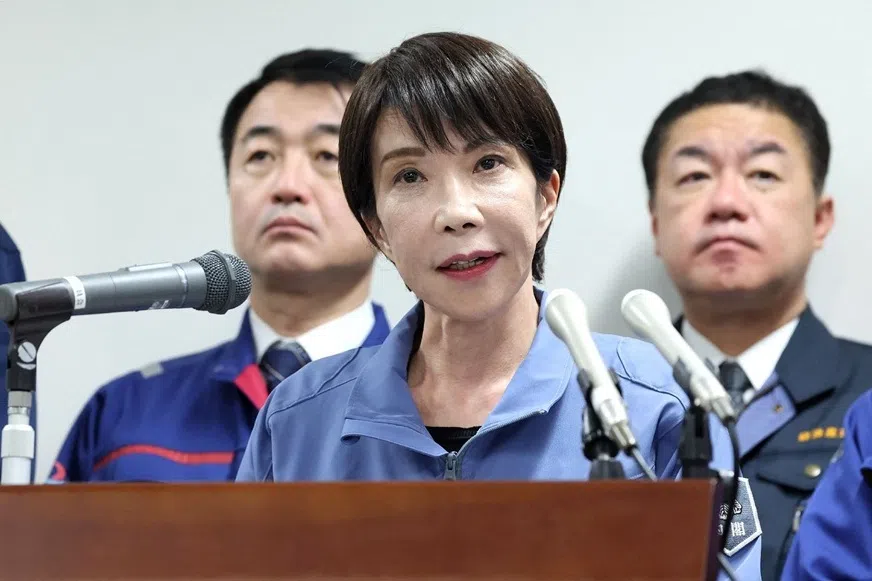

![[Big read] Love is hard to find for millions of rural Chinese men](https://cassette.sphdigital.com.sg/image/thinkchina/16fb62fbcf055b710e38d7679f82264ad682ce8b45542008afeb14d369a94399)
![[Big read] China’s 10 trillion RMB debt clean-up falls short](https://cassette.sphdigital.com.sg/image/thinkchina/d08cfc72b13782693c25f2fcbf886fa7673723efca260881e7086211b082e66c)
